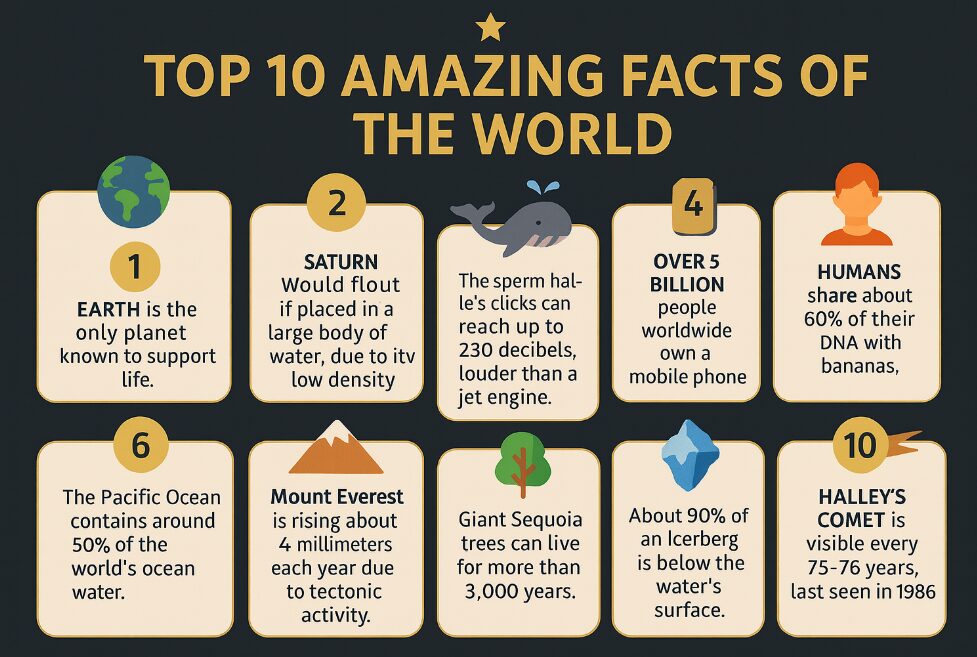Top 10 Amazing Facts Of The World
The world is full of extraordinary places, fascinating history, and surprising scientific discoveries. While you may already know a lot about famous landmarks or global records, some of the most amazing facts are often hidden in plain sight. This guide will walk you through ten of the most incredible facts about our planet and its people, supported by real data and insights. By the end, you’ll see the Earth from a fresh perspective, and maybe even have a few conversation starters for your next gathering.
1. Mount Everest Grows Every Year
At 8,849 meters (29,032 feet) above sea level, Mount Everest is the tallest mountain on Earth. But did you know it’s still growing? Due to the collision of the Indian and Eurasian tectonic plates, Everest rises by about 4 millimeters each year. That means the mountain you see today is slightly taller than it was in your parents’ time.
2. The Amazon Rainforest Produces 20% of Earth’s Oxygen
Known as the “lungs of the planet,” the Amazon covers 5.5 million square kilometers (roughly the size of Australia). It produces around 20% of the world’s oxygen and is home to at least 10% of all known species on Earth. When you take a deep breath, there’s a good chance the oxygen you inhale came from this vast green wonder.
3. Antarctica Holds Most of the World’s Freshwater
Antarctica may look like a frozen desert, but it contains about 60–70% of the world’s freshwater, locked in its massive ice sheets. If all this ice melted, global sea levels could rise by more than 60 meters (200 feet), enough to reshape coastlines everywhere.
4. The Great Wall of China Isn’t Visible from Space
A popular myth claims you can see the Great Wall from space with the naked eye. In reality, astronauts report it’s almost impossible to spot without magnification. The Wall blends into the natural landscape, unlike larger features such as city grids, airports, or deserts.
5. Lake Baikal Is the World’s Deepest and Oldest Lake
Located in Siberia, Lake Baikal is about 25 million years old and reaches a depth of 1,642 meters (5,387 feet). It holds around 20% of the world’s unfrozen freshwater, making it one of the most important water reserves on Earth.
6. The Sahara Desert Is Expanding
The Sahara, the largest hot desert in the world, spans 9.2 million square kilometers, about the size of the United States. Scientists have found it has expanded by 10% in the last century, partly due to climate change and natural weather cycles.
7. Bananas Are Berries, But Strawberries Aren’t
Botanically speaking, bananas qualify as berries because they develop from a single ovary and contain seeds inside. Strawberries, however, don’t meet the berry definition since their seeds are on the outside. This fact often surprises people, even though it’s backed by plant science.
8. The Dead Sea Is Earth’s Lowest Point on Land
The shoreline of the Dead Sea lies at about 430 meters (1,410 feet) below sea level, making it the lowest exposed point on Earth. Its water is also so salty (almost 10 times saltier than the ocean) that you’ll naturally float without effort.
9. Lightning Strikes Earth 8 Million Times a Day
Every single day, about 8 million lightning bolts strike the Earth. That’s nearly 100 lightning strikes every second. One hotspot is Lake Maracaibo in Venezuela, where storms can last up to 10 hours with thousands of strikes per night.
10. The Ocean Is Still 80% Unexplored
Despite advances in technology, scientists estimate that over 80% of the ocean remains unmapped and unexplored. This means the vast majority of marine species and underwater features are still waiting to be discovered. In other words, the world’s greatest mysteries may still lie beneath the waves.
FAQ’s
What is the most surprising fact about Earth?
Many consider the ocean’s unexplored depth the most surprising fact, since we know more about the surface of Mars than our own seabeds.
How much of the Earth is covered by water?
About 71% of Earth’s surface is water, but only 3% is freshwater, and two-thirds of that is frozen in glaciers and ice caps.
What’s the oldest living thing on Earth?
A colony of seagrass in the Mediterranean is estimated to be 100,000 years old, making it the oldest known living organism.
Can humans survive if Antarctica melts?
If Antarctica melted completely, sea levels would rise drastically, submerging many coastal cities. Humanity would survive but face massive migration, food insecurity, and economic disruption.
Why do some deserts expand over time?
Desert expansion (desertification) is often caused by a mix of climate change, drought, deforestation, and unsustainable farming practices.
The Earth is more than just your home, it’s a living, breathing system full of wonders that science is still uncovering. From the heights of Everest to the depths of the ocean, these ten facts remind you how complex, fragile, and awe-inspiring our planet truly is. By learning about these wonders, you’re not just expanding your knowledge, you’re also better equipped to appreciate and protect the only world we have.

